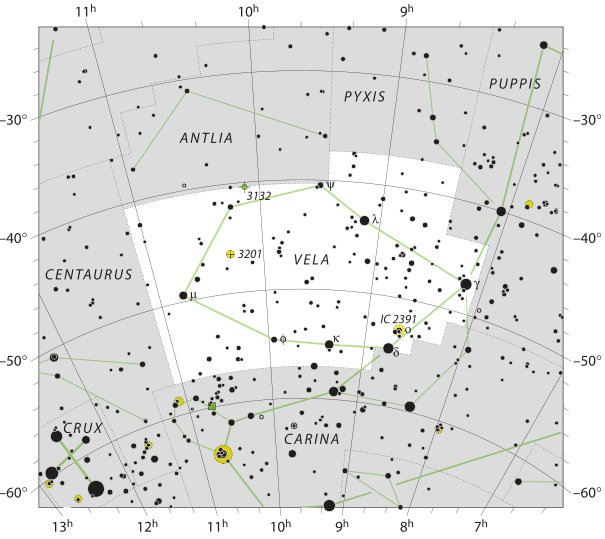The first of the Vela stars (with a Greek letter) to rise is γ and then there are ο and δ, before Alsuhail arrives. It looks as if the not very bright o-mikron (ο) could offer a better point from where to cross over to Alsuhail than δ. Furthermore, a little 'egg' might be depicted in the center of Ca5-20 (hakapekaga mai). Beyond Alsuhail are κ, ψ, φ, and μ:
These are the 7 new stars:
I learned the name Xestus for ο Velorum from Wikipedia, but with no explanation of what it means. Wikipedia also listed the name Koo She for δ Velorum and here Allen is helpful: "δ, 2.2, and ω, with stars in Canis Major, were the Chinese Koo She, the Bow and Arrow." By simply looking at the glyphs Ca5-25 (ο) and Ca5-27 (δ) it is hard to see if any of these stars could indicate a point of departure for the crossing. However, 5-25 could point at Ca5-20 because 5 * 25 = 125 (which is the RA day number corresponding to July 24). Furthermore, there is a striking similarity between Xestus and Beehive (ε Cancri) - not only are they rising practically simultaeously but there is also a yellow circular mark around both places in the star charts:
M44 is Messier 44, the Beehive Cluster, and IC2391 is number 2391 in the Index Catalogue of Nebulae and Clusters of Stars. "IC 2391 (also known as the Omicron Velorum Cluster or Caldwell 85) is an open cluster in the constellation Vela. The Persian astronomer Al Sufi may have first described it about 964. It was found by Abbe Lacaille and cataloged as Lac II 5." (Wikipedia) In G the stars Beehive and Xestus are at a tagata figure with tall neck, eye and fist in front, together with a hipu leg. These signs could indicate the end of a dark time (no eye at left) in constrast to a new generation in front. The following manu rere with an uplifted front wing (and tail) is in harmony with such an interpretation:
Aldebaran rose heliacally in RA day 68 and Alhena 9 is manzil day 75. 68 + 7 = 75. I therefore imagine the crossing could be connected with X-estus:
July 29 can be written 7-29 and 72 * 9 = 648 (= 8 * 81). 7 * 29 = 203 could allude to the first star to rise in Vela, viz. Regor (γ) in July 22 (Alhena 1).. "Gamma Velorum (γ Vel, γ Velorum) is a star system in the constellation Vela. At magnitude +1.7, it is one of the brightest stars in the night sky. It has the traditional names Suhail and Suhail al Muhlif, which confusingly also apply to Lambda Velorum. It also has a more modern popular name Regor, which was invented as a practical joke by the Apollo 1 astronaut Gus Grissom for his fellow astronaut Roger Chaffee. Due to the exotic nature of its spectrum (bright emission lines in lieu of dark absorption lines) it is also dubbed the 'Spectral Gem of Southern Skies'." (Wikipedia) | |||||||||||||||||||||||||||||||||||||||||||||||||||||||||||||||||||||||||||||||||||||||||||||||||||||||||||||||||||||||||||||||||||||||||||||||||||||||||||||||||||||||||||||||||||||||||||||||||||||||||||||||












